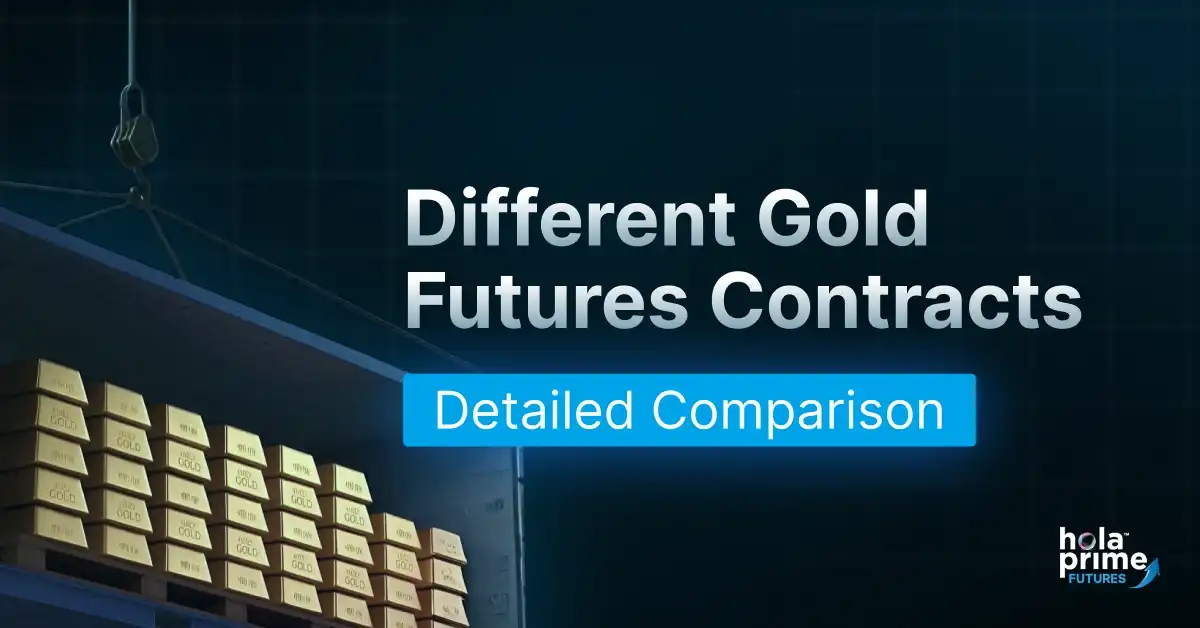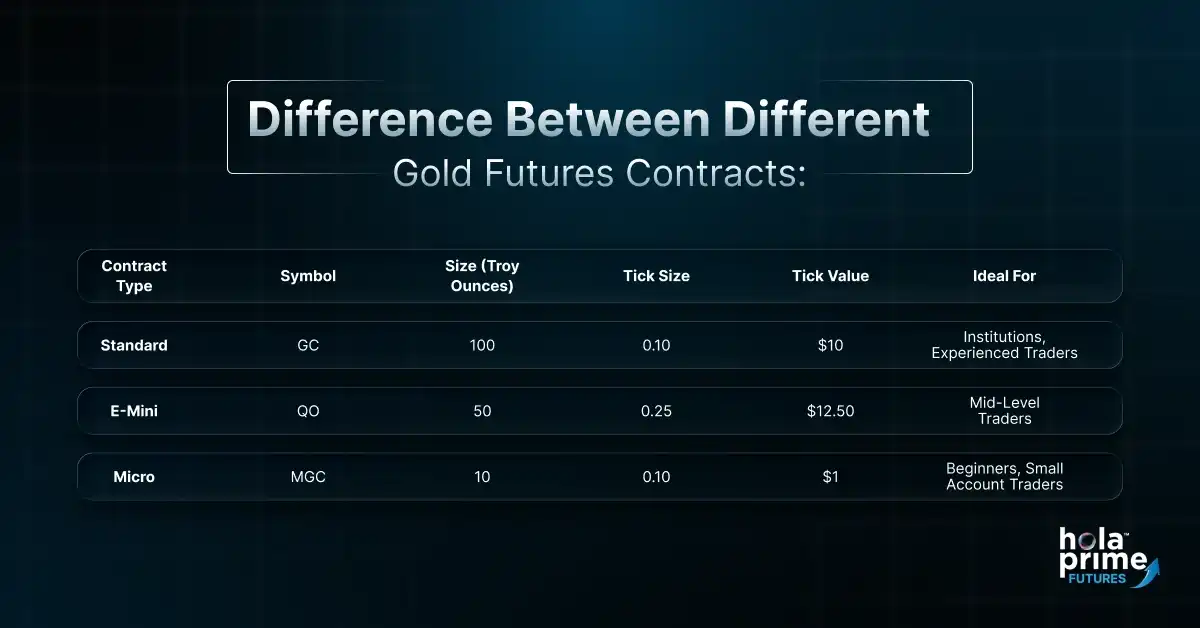Different Gold Futures Contracts: Detailed Comparison
- Ankit Gupta
- August 20, 2025

Introduction:
If you’re thinking about adding gold to your trading plan, you must have heard about “gold futures.” You might have even checked some price charts and felt ready to dive in. But hold up. There’s something a lot of beginners miss – gold futures aren’t all the same. The kind of contract you trade matters a lot. Your account size, how much risk you can handle, and your goals as a trader all play a role in picking the right one. In this post, we’ll break down the types of gold futures contracts, who they work best for, and how to choose the right fit for your strategy. No matter if you’re a seasoned trader or just starting out, this breakdown will help you understand everything about gold futures. Let’s get started.
What are Gold Futures Contracts?
Gold futures are contracts that let people agree to buy or sell a fixed amount of gold at a certain price on a future date. These deals happen on official exchanges like COMEX, which is part of CME Group. They let traders predict gold’s future price without owning the metal. Since there’s no need to store real gold, they are popular with institutions, day traders, and hedgers who want to follow gold’s price changes. You can think of it as a way to trade on gold’s value while using leverage and accessing a market that’s both clear and easy to enter.
Why Trade Gold Futures?
Gold has always been a go-to choice during unstable periods. Beyond the sentimental value people attach to it, gold behaves as a technical asset that reacts to shifts in interest rates, inflation, and worldwide political changes. Traders aiming to make gains from market swings or protect other investments can explore gold futures. These contracts operate in a liquid market around the clock, offering chances to do both.
Leverage is another advantage here. Even a small account balance can control a much larger amount of gold’s value, which can mean gains but also introduces risk. Gold futures make both short selling and long positions easy, unlike ETFs or physical gold, which gives traders options whether the market is rising or falling.
Types of Gold Futures Contracts:
When people talk about “gold futures,” many think there’s one kind. In truth, there are three major types you should learn about: the standard gold futures contract, the E-mini gold futures, and the Micro gold futures. Each comes with specific margin rules, tick values, and suits different types of traders. Let’s take a closer look at these:
1. Standard Contracts:
The standard gold futures contract holds the spotlight as the big player in the market. Each contract equals 100 troy ounces of gold. Traders buy and sell based on the pricing offered by the COMEX exchange. Its large size makes it more practical for institutional traders or experienced retail traders with big budgets.
A tick here is 0.10 points, and every tick shift means $10. So, if the price moves by a full point, that’s $100 per contract. Trading this requires solid risk control since even one day’s movement might erase a small trading account if you’re not cautious. The margin needed often reaches several thousand dollars, depending on how volatile the market is.
2. E-Mini Contracts:
The E-mini gold futures contract was created to be a simpler alternative to the standard gold contract. It covers 50 troy ounces of gold, which is half the size of the standard GC contract. It allows traders to take part in the gold market without needing as much money up front.
This makes it a good option for well-funded retail traders or smaller trading firms. The smaller tick sizes and dollar amounts make it helpful to control risks. Even though it is a smaller contract, it still trades on the COMEX and provides solid liquidity during key trading hours.
3. Micro Contracts:
Micro gold futures are the smallest contracts you can trade, covering 10 troy ounces of gold per contract. They were made to help individual retail traders who want to try out gold futures without needing to risk too much money. With a tick size of $1, you can adjust your positions more without feeling pressured by minor price changes. These Micro contracts work well for beginners learning about futures or for testing out new strategies. They also let traders experience gold markets without the higher risks tied to standard or E-mini contracts.

How to Choose the Right Futures Contracts?
Picking the right futures contract isn’t just about how much money’s in your account. It’s a good starting point, but you should also think about a few important questions:
- How much money am I okay with putting at risk on each trade?
- Do I prefer having bigger exposure on every trade, or do I need more room to adjust positions as I go?
- Am I focused on quick daily trades or longer-term swing trades?
- How sure am I about my trading approach and how fast I can act?
When you’re just starting out or trying a fresh strategy, Micro contracts can be your safest choice. They let you make errors without destroying your account. As your skills and confidence improve, switching to E-mini contracts can give you the chance to earn more while still keeping risks controlled. After you make profits and understand market swings you should think about moving to the Standard GC contract. Bigger positions bring more pressure unless you have a setup that can handle it.
Risks and Important Things to Consider While Trading Gold Futures:
Trading gold futures is not just about shiny profits. Like other leveraged tools, the risks can pile up fast if you lack discipline. Pay attention to a few risks and points worth thinking about:
1. Leverage Works Both Ways:
Leverage that increases your earnings also makes your losses bigger. Match the size of your trades to what you can afford to lose, not to some big dream of quick wealth.
2. Volatility Exists:
Gold is a worldwide asset, and its price can jump or drop because of economic reports, political events, or changing interest rates. Big price shifts might lead to margin calls if your trade size is too risky.
3. Liquidity Isn’t All the Same:
The largest trading volume comes from standard contracts. But smaller options like Micro and E-Minis are gaining traction as more retail traders dive in. Liquidity can still drop during off-hours though, so keep that in mind.
4. Execution Costs Build Up:
When you trade a lot, fees and slippage can chip away at your earnings. This can hit smaller contracts harder. Make sure to consider these costs when planning your approach.
Conclusion:
When you are trading futures, it is important that you have a clear understanding of how they work and how you can fit them into your overall strategy. Start small, know your trading plan and only increase the value of your trade as your track record becomes more evident and you establish confidence that you are ready to increase your trading size.
Trading gold and other commodities can be rewarding; it doesn’t simply happen. You must also have a clear trading plan and a solid understanding of your tools. It is worth repeating – in the world of futures, just as the market direction matters, so does the futures contract you select.
FAQs: Portfolio Diversification
1. Which gold futures contract is best for beginners?
The Micro Gold Futures (MGC) are perfect for beginners. They let you dip your toes into futures trading without risking too much capital. You can learn how gold moves and manage risk more easily.
2. How much money do I need to trade gold futures?
That depends on the contract size and your broker’s margin requirements. For Micro contracts, you can start with as little as a few hundred dollars. Standard contracts might need $7,000 or more just for the initial margin. If you choose to trade gold futures with a prop firm, you can start with as little as $98 a month.
3. What happens if I hold a gold futures contract until expiration?
If you don’t close or roll it before expiration, you may be assigned physical delivery – yes, actual gold. Most retail traders avoid this by closing positions early or rolling to a later month.
4. Are gold futures suitable for day trading?
Absolutely. Many day traders prefer gold futures because of the liquidity and volatility. The Micro contract especially lets you trade intraday moves with tighter risk. Just make sure your strategy matches the speed of the market.
5. How do I decide which gold futures contract is right for me?
It depends on your experience, capital, and risk tolerance. You should choose a futures gold contract based on how much capital you have and your previous experience. If you are already familiar with a particular type of contract, you may benefit from your knowledge.
Disclaimer: All information provided on this site is for educational purposes only, related to trading in financial markets. It is not intended as financial advice, business or investment recommendation, or as an opportunity or recommendation to trade any investment instruments. Hola Prime only provides an educational environment to traders, including tools, materials and simulated trading platforms which have data feed provided by Liquidity Providers. The information on this site is not directed at residents in any country or jurisdiction where such distribution or use would be contrary to local laws or regulations.

